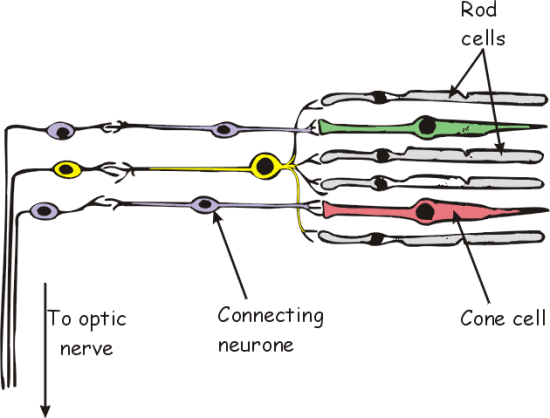Retina
The retina is the light sensitive layer which is responsible for 'seeing' light. The retina is composed of two types of light sensitive cells.
- Rod cells
- These cells are capable of seeing only different degree's of light intensity and cannot distinguish colour. As a result they can only see in black and white. They are able to sense low levels of light and so are used for seeing in dim light such as at night but do not work in bright light. This is because they only work when a chemical called visual purple is formed and bright light bleaches it. In dim light visual purple is re-formed, but this takes time. This is why we need to let our eyes 'adjust' in dim light. It is also why when we are dazzled by bright light we suddenly lose our night vision as we wait for more visual purple to be made.
- Cone Cells
- There are three different types of cone cell, each sensitive to a different colour of light. The three cells are sensitive to the three primary colours of light, red, green and blue. These cells need a great deal of light in order to work and as a result are not able to 'see' in dim light. The cells are mixed together so that different colours can be seen. For example, if yellow light is shone on the retina, both the red and green cone cells with sense the light and send a message to the brain. The brain then interprets this as yellow light.
Resolution
Resolution is described as the ability to distinguish between to very close objects. If resolution is poor then often the two objects will appear as just one object. If resolution is good then they will appear to be two separate objects.

The diagram above shows the layout of some cells in the retina. The cells have been coloured for clarity. There are two cone cells in the diagram, each with its own neurone. If light shines on the red cone cell then it will stimulate the connecting neurone attached to it and an electrical impulse will travel to the brain and will register the fact that light has been seen in that position. If light hit the green cone cell, just a fraction of a millimetre away, then a different neurone is triggered and what is seen is slightly different due to the position of the cone cells.
Notice now that rod cells are all attached to the same connecting neurone. If light shines on the right hand rod cell and not the others, the effect is the same as if the left most rod cell was stimulated. This means that it is not as easy to distinguish between two objects which are close together when seeing with the rods cells. This is why when we see in dim light, (when our rod cells are doing the 'seeing') the image is not as clear as in bright light (when our cone cells are doing the 'seeing'). The concentration of cone cells is at its highest at the fovea (yellow spot) which lies directly behind the lens. This is the area which has greatest resolution. When we look at things, the image which falls here is the clearest. The concentration of cone cells becomes less as you move away from the fovea and so the resolution at the periphery of our vision is less acute. This is why when we are reading, the word we are concentrating on at the moment is very clear while words on either side are progressively blurry.
